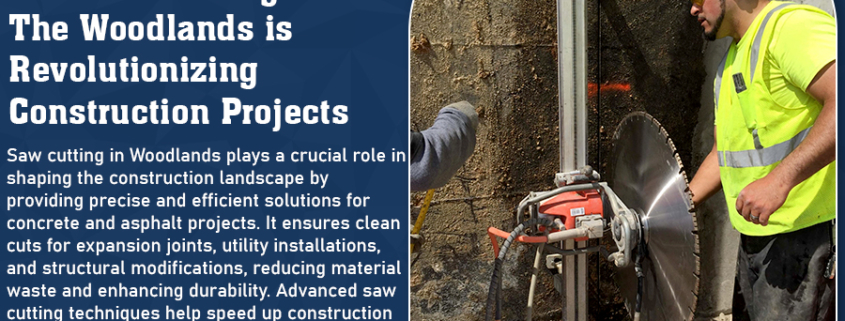How Saw Cutting The Woodlands is Revolutionizing Construction Projects
In the world of construction, precision, efficiency, and safety are paramount. As the demand for modern, high-quality infrastructure grows, contractors are increasingly relying on advanced techniques to meet these expectations. One such technique that has gained significant traction in The Woodlands area is saw cutting. Whether it’s for concrete, asphalt, or other materials, saw cutting has become a game-changer in the construction industry, providing solutions for everything from road repairs to complex building foundations.
Let’s explore how Saw Cutting The Woodlands is revolutionizing construction projects.
What is Saw Cutting?
Saw cutting is the process of using specialized power saws equipped with diamond blades to make precise cuts into hard materials such as concrete, asphalt, and stone. The method ensures smooth, straight lines and minimal disruption to surrounding structures. With various saw types and cutting methods, this technique is adaptable to different construction needs, making it a versatile choice for contractors in The Woodlands and beyond.
Improving Precision and Efficiency
In construction, precision is key. Traditional methods of cutting through hard materials could be imprecise, leading to costly mistakes and delays. Saw cutting eliminates these risks by offering accurate, clean, and controlled cuts. Whether the project involves cutting expansion joints in concrete or trenching for utilities, saw cutting allows contractors to achieve the exact dimensions required without compromising the integrity of the material.
Additionally, saw cutting significantly boosts efficiency. Unlike older techniques that may involve manual labor or slower equipment, modern saw cutting tools are faster, allowing construction teams to complete jobs more quickly and with less effort. The ability to cut through dense materials in a fraction of the time has drastically improved the overall timeline of construction projects, helping projects stay on schedule and within budget.
Versatility for Various Applications
One of the primary reasons saw cutting has become so essential to construction projects in The Woodlands is its versatility. The technique can be used for a wide range of applications, from minor residential repairs to large-scale commercial projects. Some common uses for saw cutting include:
Concrete Cutting: Contractors frequently use saw cutting to create expansion joints in concrete, providing space for the material to expand and contract with temperature changes. This is particularly important in larger projects like highways and parking lots.
Road Repairs: Saw cutting is vital for precise cuts when repairing asphalt roads or removing damaged sections. This method allows for a seamless connection between old and new material, ensuring a smooth, even surface.
Utility Trenches: When digging trenches for utilities like water, electricity, and gas lines, saw cutting is often employed to make clean cuts in the surface without damaging the surrounding infrastructure.
Floor and Wall Cutting: Saw cutting is also widely used in both residential and commercial construction to create doorways, windows, or other openings in walls and floors without creating unnecessary damage to the surrounding areas.
Improving Safety on Job Sites
Safety is a top priority in the construction industry, and saw cutting plays a significant role in increasing safety on job sites in The Woodlands. The process is much safer compared to older cutting methods, which may involve more manual labor or less accurate equipment. With saw cutting, workers can remain at a safe distance from the cutting tool, reducing the risk of injury.
Additionally, modern The Woodlands Saw Cutting tools are designed to produce minimal dust and debris, creating a cleaner and safer work environment. By reducing the amount of airborne particles, contractors can ensure that workers and passersby are protected from potential health hazards. This is particularly important in urban areas like The Woodlands, where construction sites are often located near residential or commercial properties.
Minimizing Environmental Impact
As the construction industry becomes more conscious of its environmental footprint, saw cutting offers a more eco-friendly alternative to traditional methods. The use of diamond blades and power tools reduces the need for chemical solvents or hazardous materials that might otherwise pollute the surrounding environment. Furthermore, because saw cutting is precise and efficient, there is less waste produced, contributing to a more sustainable construction process.
The ability to make clean, precise cuts also minimizes the need for excessive demolition, which can result in large amounts of debris that require disposal. This aspect of saw cutting not only saves time and money but also reduces the environmental impact of construction projects in The Woodlands.
Cost-Effectiveness in the Long Run
While saw cutting may require an initial investment in specialized equipment, its long-term benefits far outweigh the upfront costs. The increased speed and precision lead to reduced labor costs and fewer mistakes, which translates into lower overall expenses for construction projects. Moreover, the reduced waste and environmental impact can help companies avoid potential fines or additional costs associated with waste disposal.
Furthermore, the durability of saw-cut materials ensures that the finished product will stand the test of time. For instance, a saw-cut concrete surface is often more reliable and less prone to cracking compared to surfaces that were cut using older methods. This translates into fewer maintenance costs in the future, making saw cutting a cost-effective choice for both short-term and long-term projects.
Future Trends in Saw Cutting for Construction in The Woodlands
As technology continues to advance, so too does the world of saw cutting. In The Woodlands, contractors can expect to see even more innovations in the technique. The development of robotic saw cutting machines, for example, could further reduce labor costs and improve precision. Additionally, advancements in blade technology will likely allow saw cutting tools to cut through even tougher materials, expanding the range of applications for this technique.
The future of construction looks promising, and saw cutting will undoubtedly remain at the forefront of these innovations. Whether for residential, commercial, or infrastructure projects, saw cutting will continue to play a key role in shaping the landscape of the area.
Conclusion
Saw Cutting The Woodlands has become an indispensable tool in the construction industry, offering unparalleled precision, efficiency, and safety. By improving the quality of work, minimizing waste, and reducing costs, this cutting-edge technique is revolutionizing the way construction projects are carried out in the region.
As the industry evolves, saw cutting will continue to be a critical player in the successful completion of projects that help shape The Woodlands into a thriving community.








